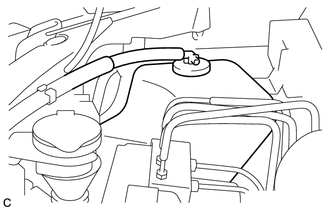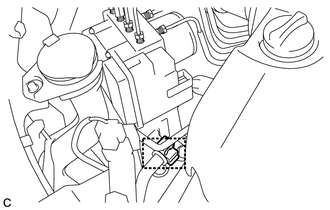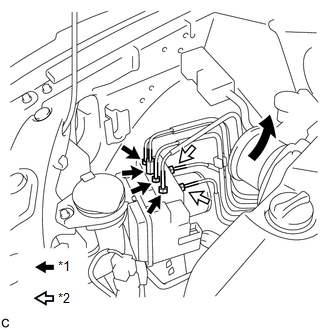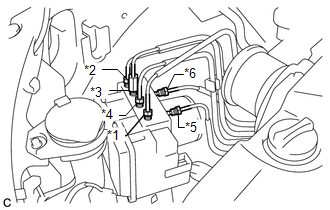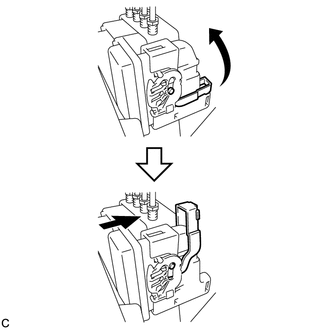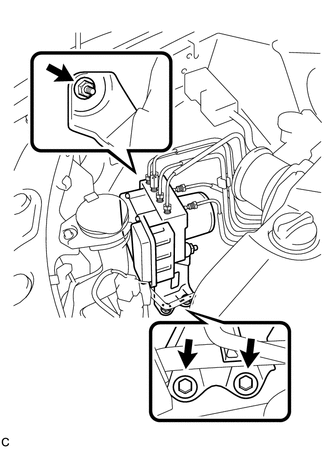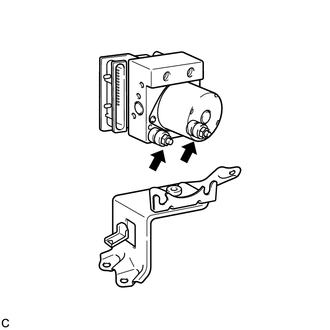Toyota Venza: Removal
REMOVAL
PROCEDURE
1. DISCONNECT CABLE FROM NEGATIVE BATTERY TERMINAL
NOTICE:
When disconnecting the cable, some systems need to be initialized after the cable
is reconnected (See page .gif) ).
).
2. REMOVE RADIATOR RESERVE TANK ASSEMBLY
|
(a) Remove the radiator reserve tank assembly. |
|
(b) Remove the radiator reserve tank cap assembly.
3. REMOVE BRAKE ACTUATOR WITH BRACKET
|
(a) Remove the clamp and separate the suction hose sub-assembly from the brake actuator bracket assembly. |
|
|
(b) Using union nut wrenches (10 mm and 12 mm), disconnect the 6 brake lines from the brake actuator with bracket. Text in Illustration
|
|
|
(c) Use tags or make a memo to identify the places to reconnect. Text in Illustration
|
|
|
(d) Release the lock lever and disconnect the brake actuator connector. NOTICE: Be careful not to allow brake fluid to enter the removed connector. |
|
|
(e) Remove the nut, 2 bolts and brake actuator with bracket from the body. NOTICE: Do not damage the brake lines or wire harness. |
|
4. REMOVE BRAKE ACTUATOR ASSEMBLY
|
(a) Loosen the 2 nuts and remove the brake actuator assembly from the brake actuator bracket assembly. |
|
 On-vehicle Inspection
On-vehicle Inspection
ON-VEHICLE INSPECTION
PROCEDURE
1. CONNECT TECHSTREAM
(a) Connect the Techstream to the DLC3.
(b) Start the engine and run it at idle.
(c) Enter the following menus: Chassis / ABS/VSC/TRAC / Acti ...
 Installation
Installation
INSTALLATION
PROCEDURE
1. INSTALL BRAKE ACTUATOR ASSEMBLY
(a) Install the brake actuator assembly to the brake actuator bracket
assembly with the 2 nuts.
Torque:
8.0 N·m {82 ...
Other materials about Toyota Venza:
Security Indicator Light Circuit
DESCRIPTION
Even when the theft deterrent system is in the disarmed state, the security indicator
blinks due to a signal output from the immobiliser system. The security indicator
blinks continuously due to a continuous signal received from the immobilise ...
Sound of Portable Player cannot be Heard from Speakers or Sound is Low
PROCEDURE
1.
CHECK PORTABLE PLAYER SETTINGS
(a) Check the portable player settings.
(1) Check that the volume is not set to "0".
(2) Check that mute is off.
(b) Check that the sound of the portable player can be h ...
Basic Inspection
BASIC INSPECTION
When the malfunction is not confirmed by the DTC check, troubleshooting should
be carried out in all circuits considered to be possible causes of the problem.
In many cases, by carrying out the basic engine check shown in the following pr ...
0.117

